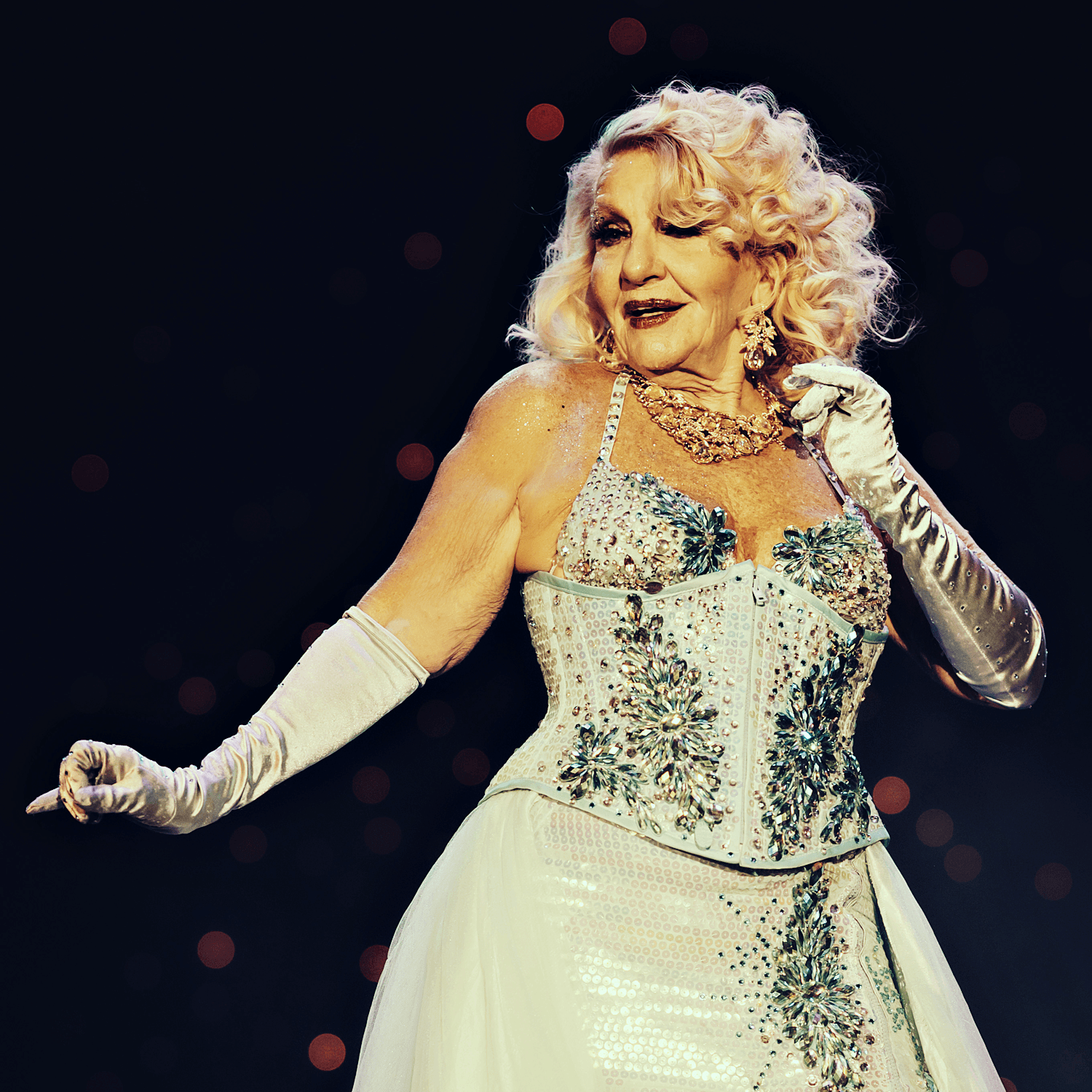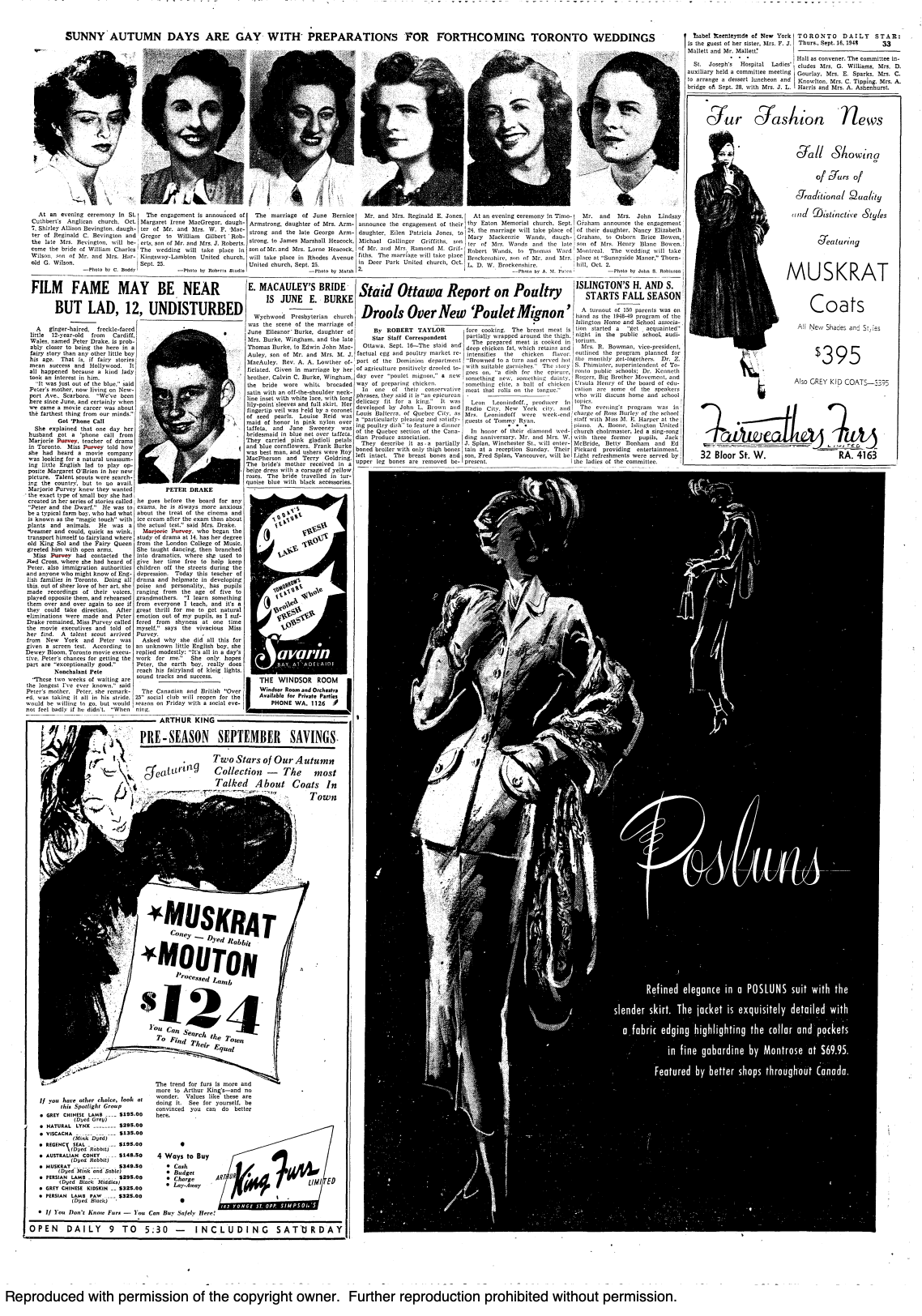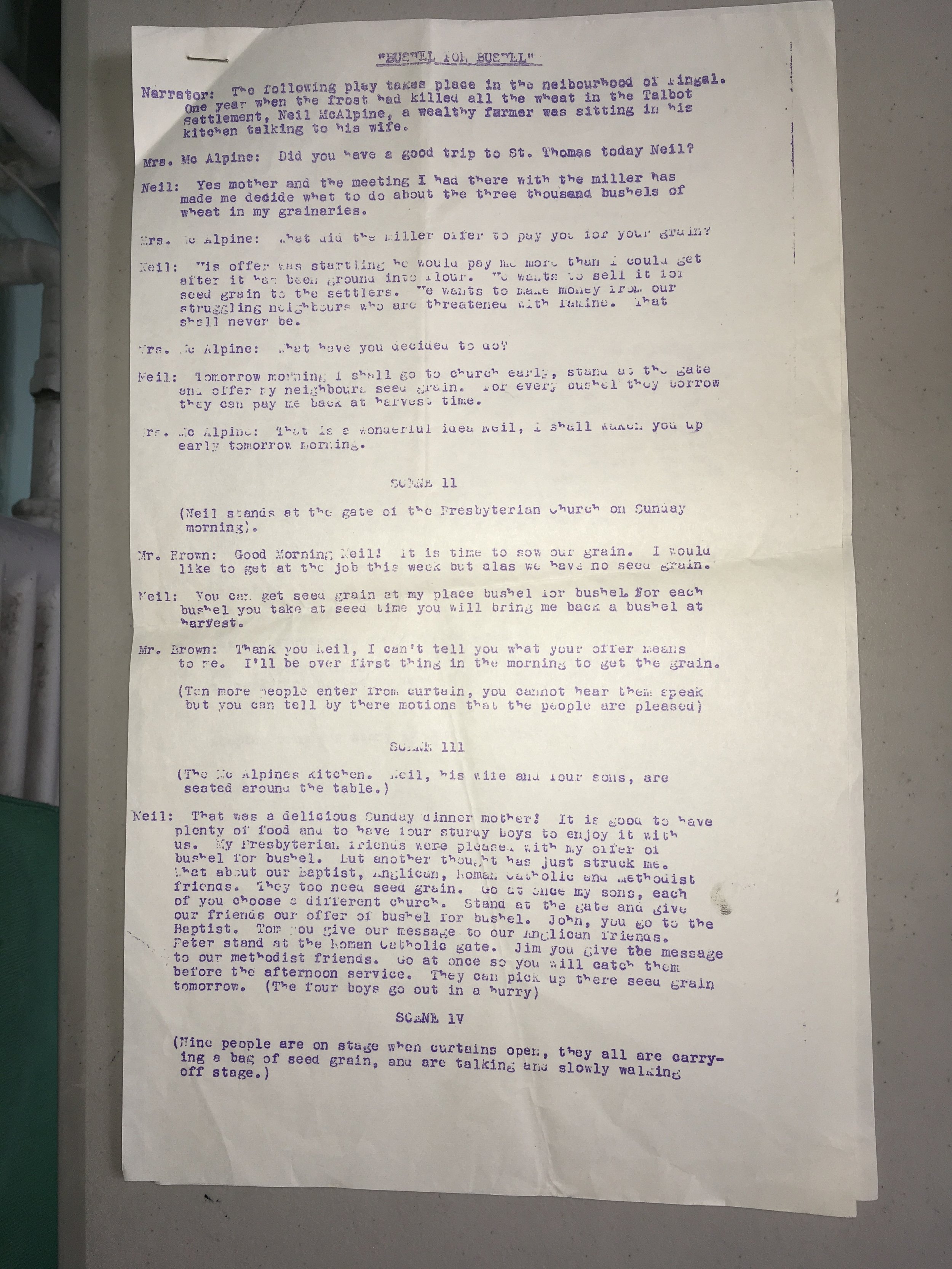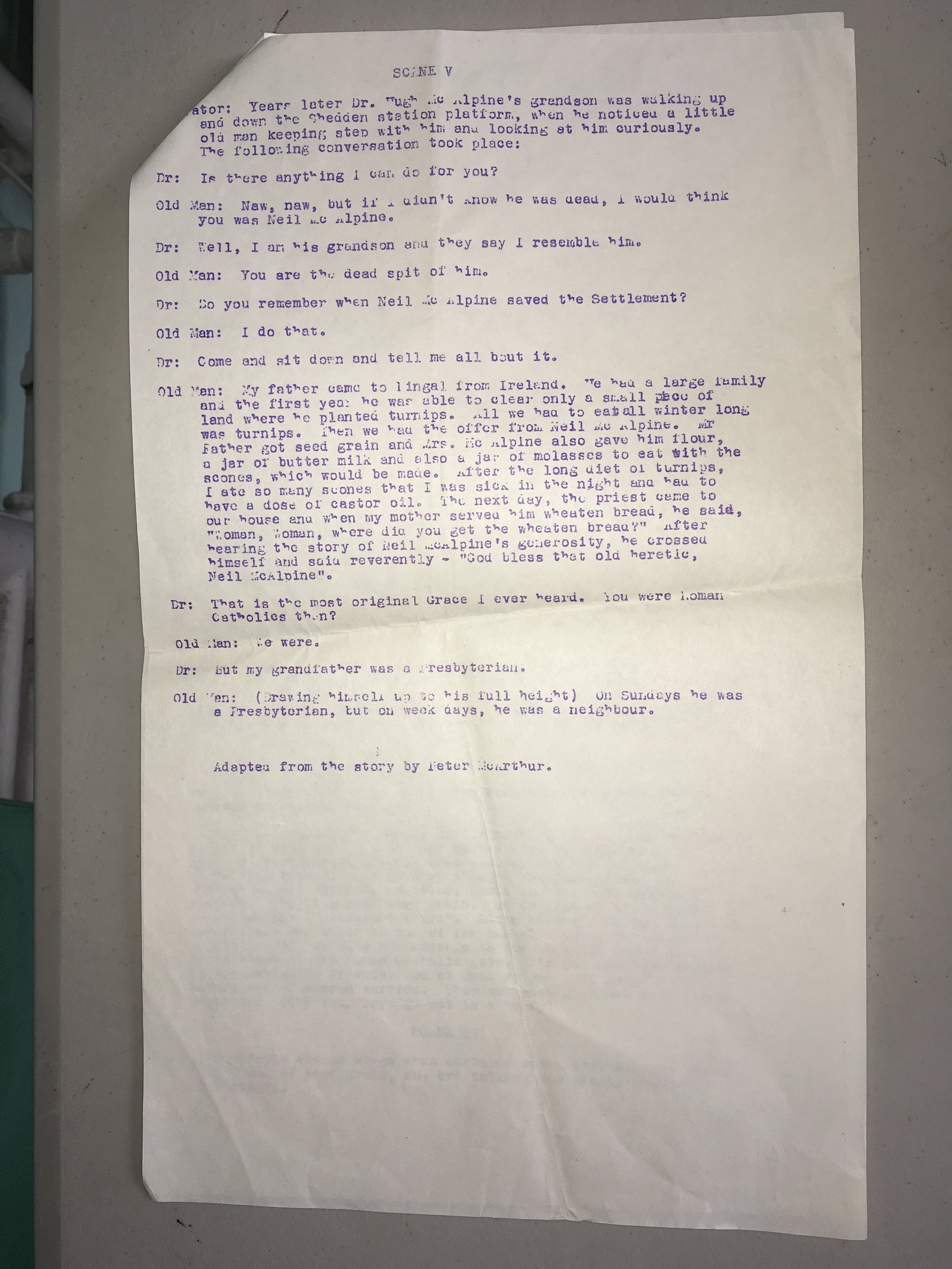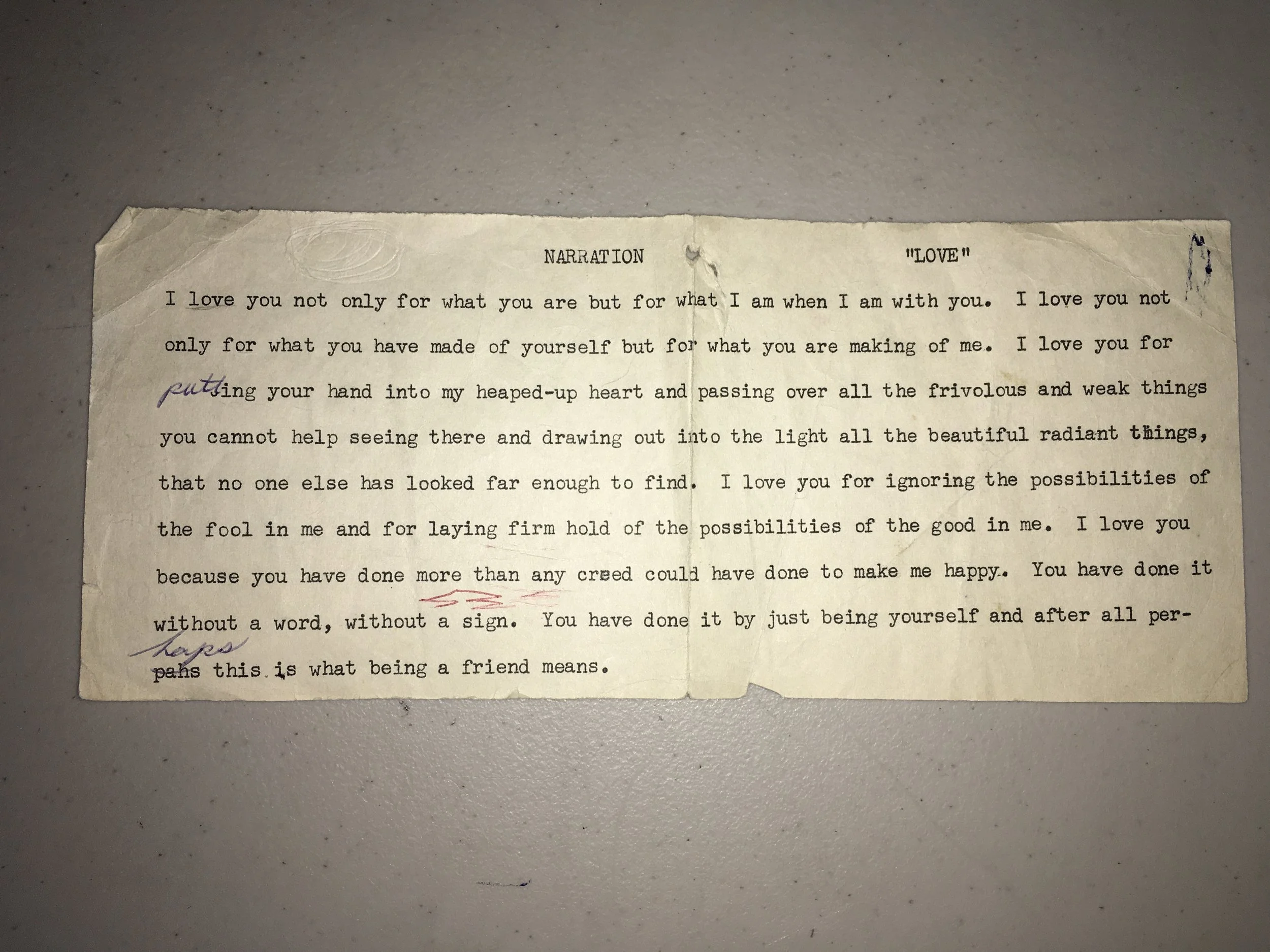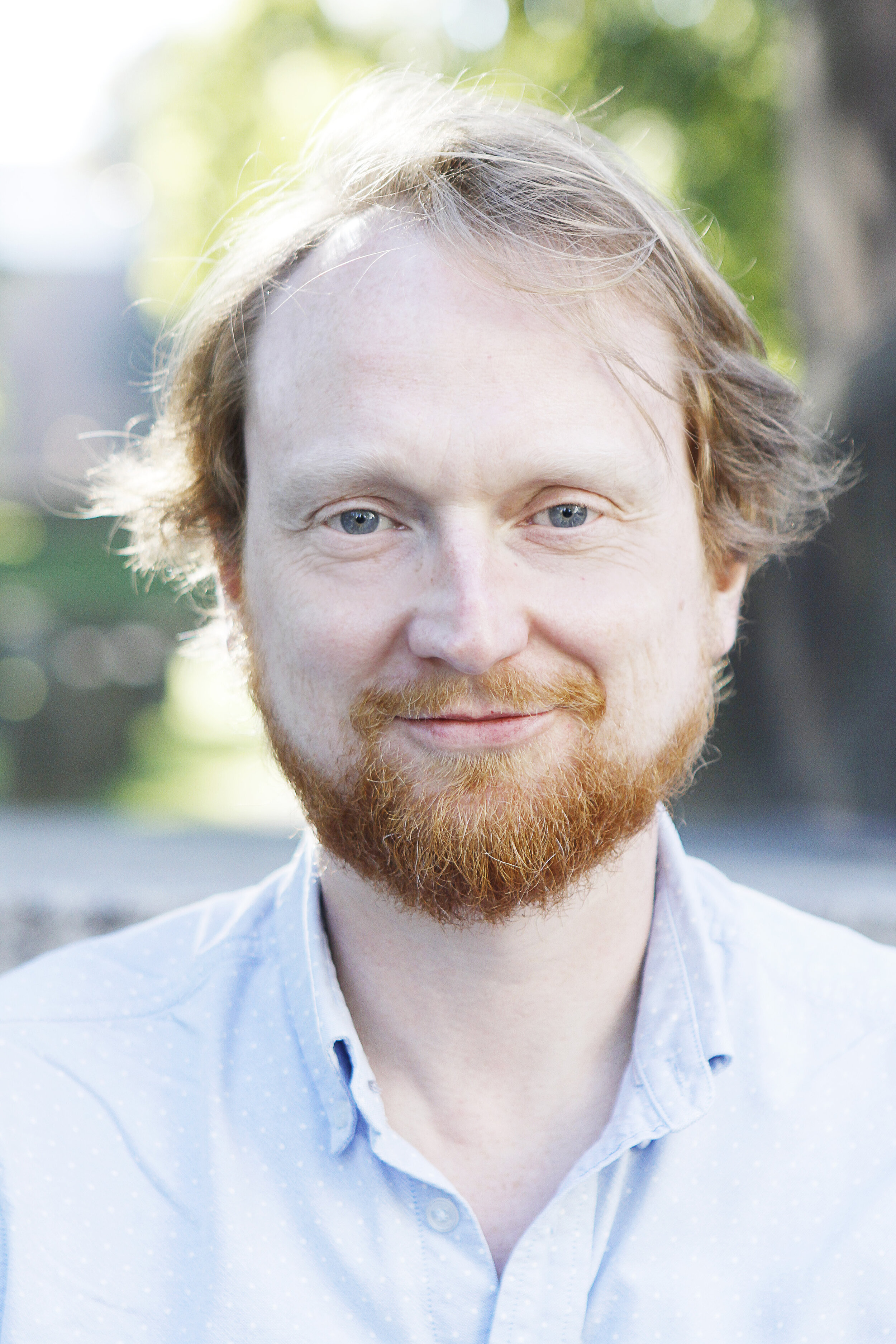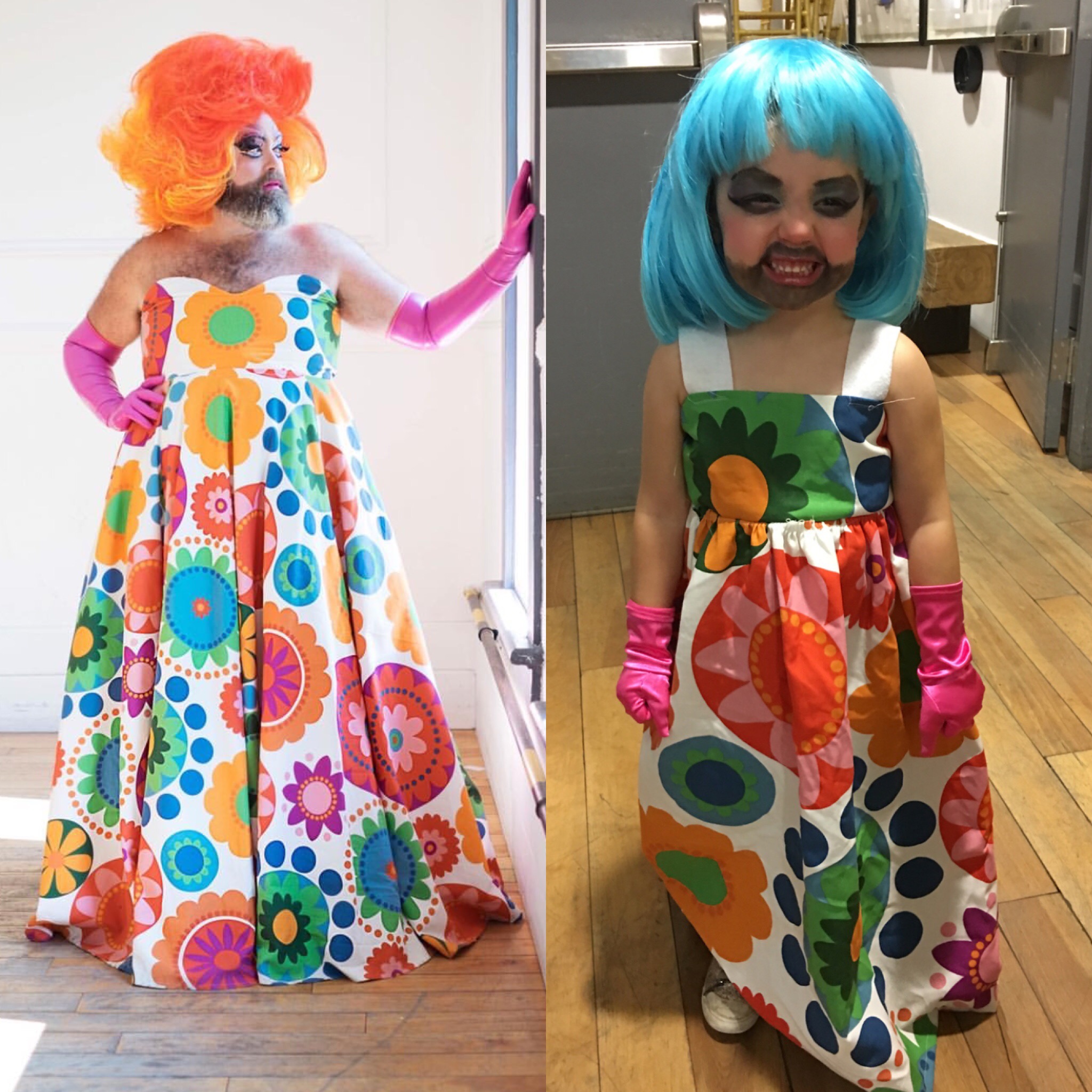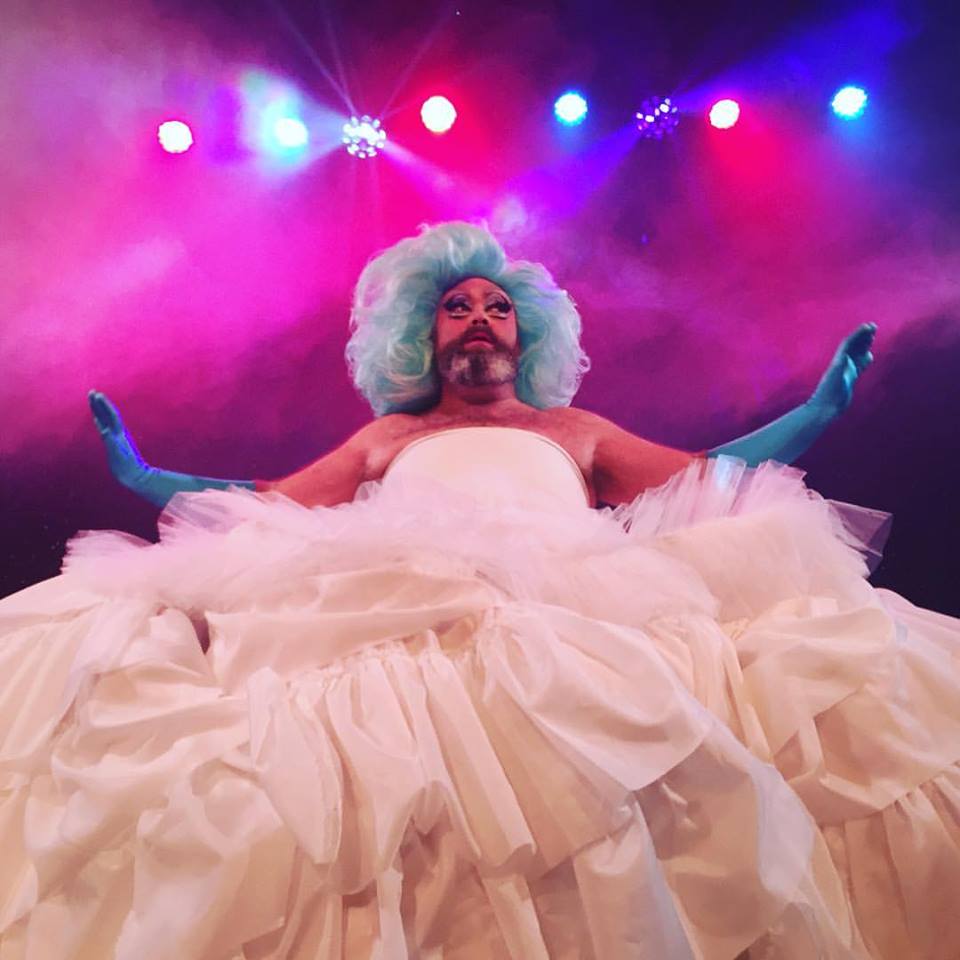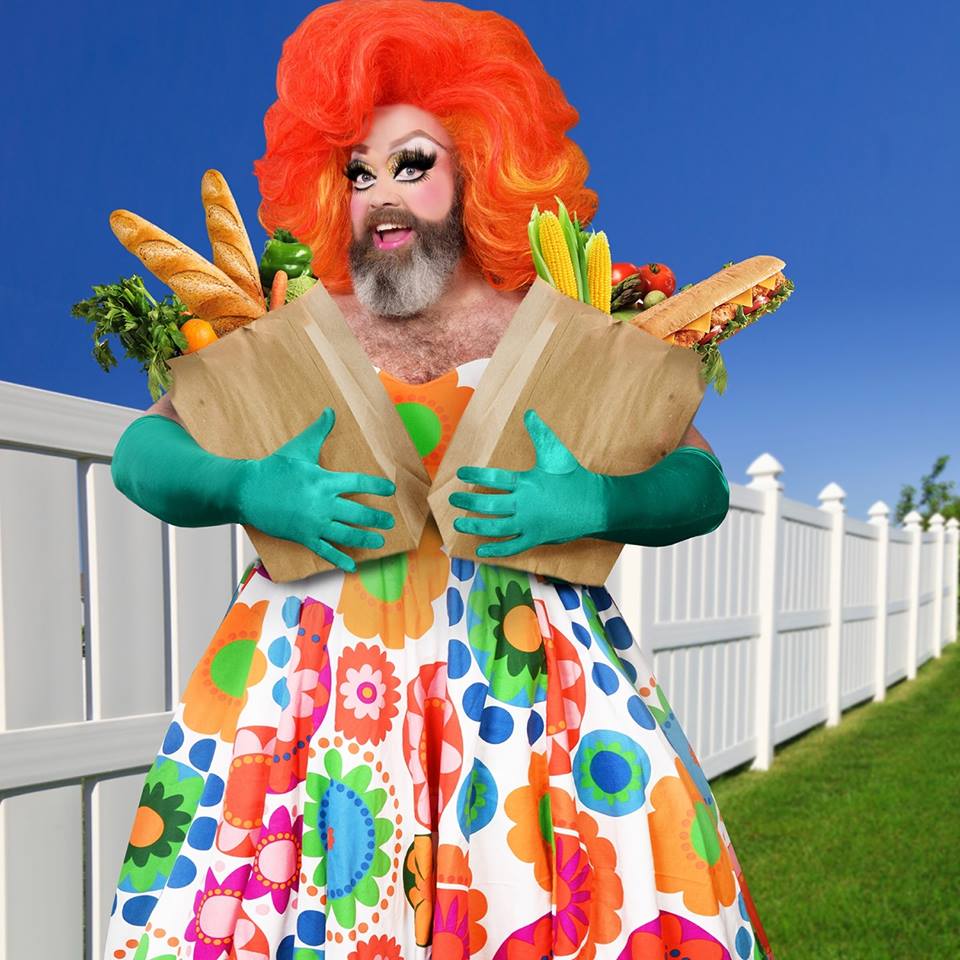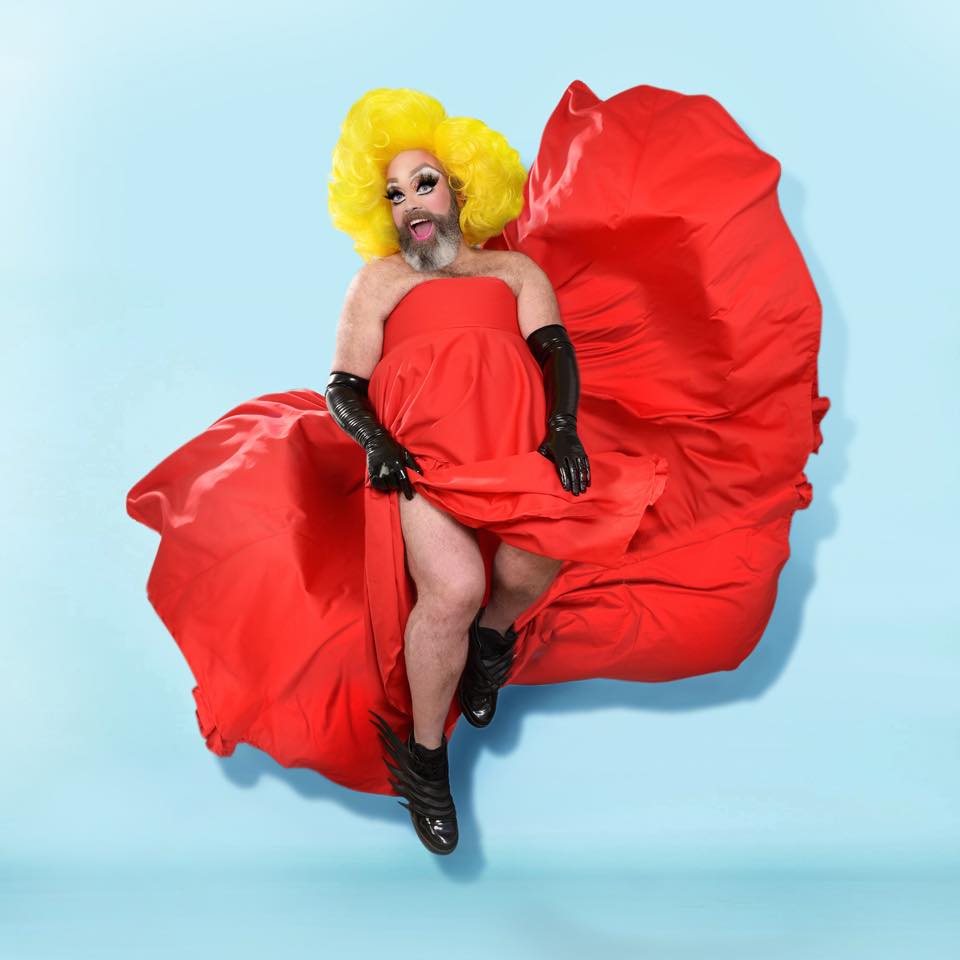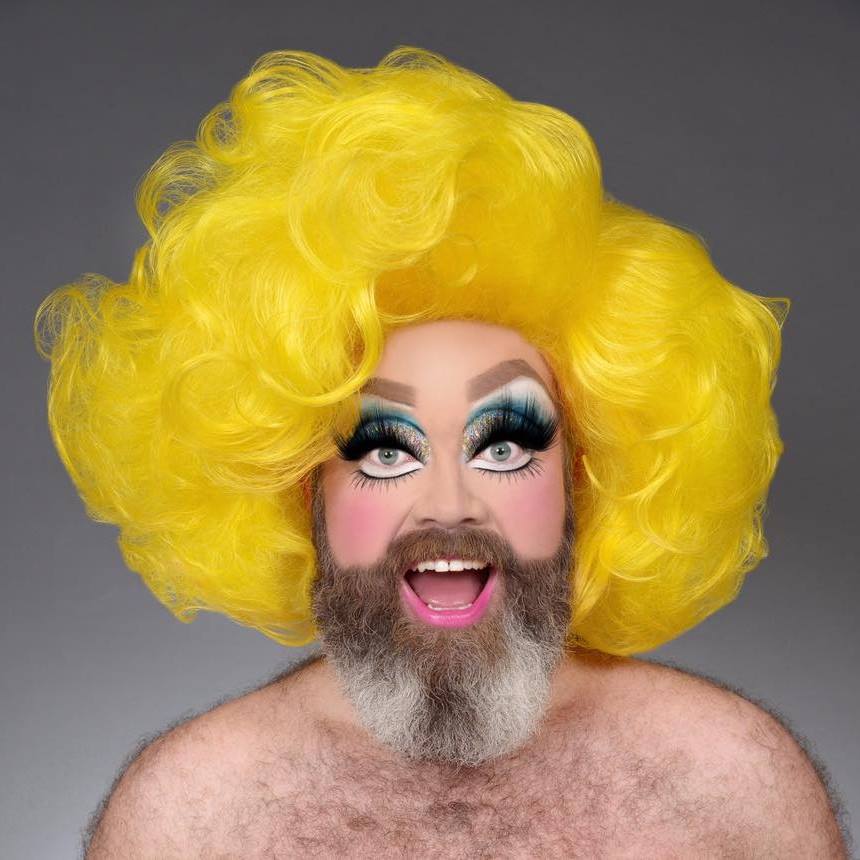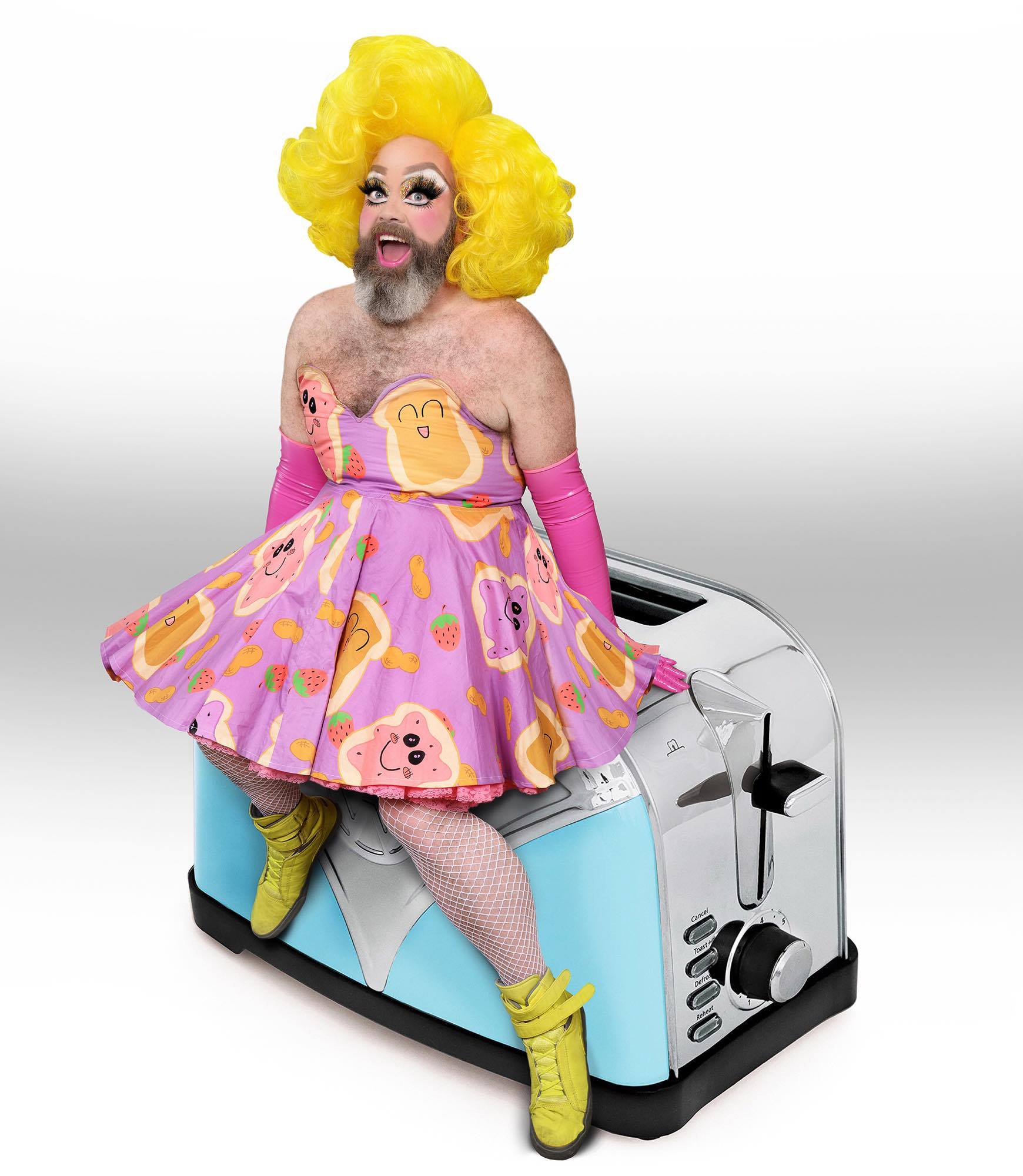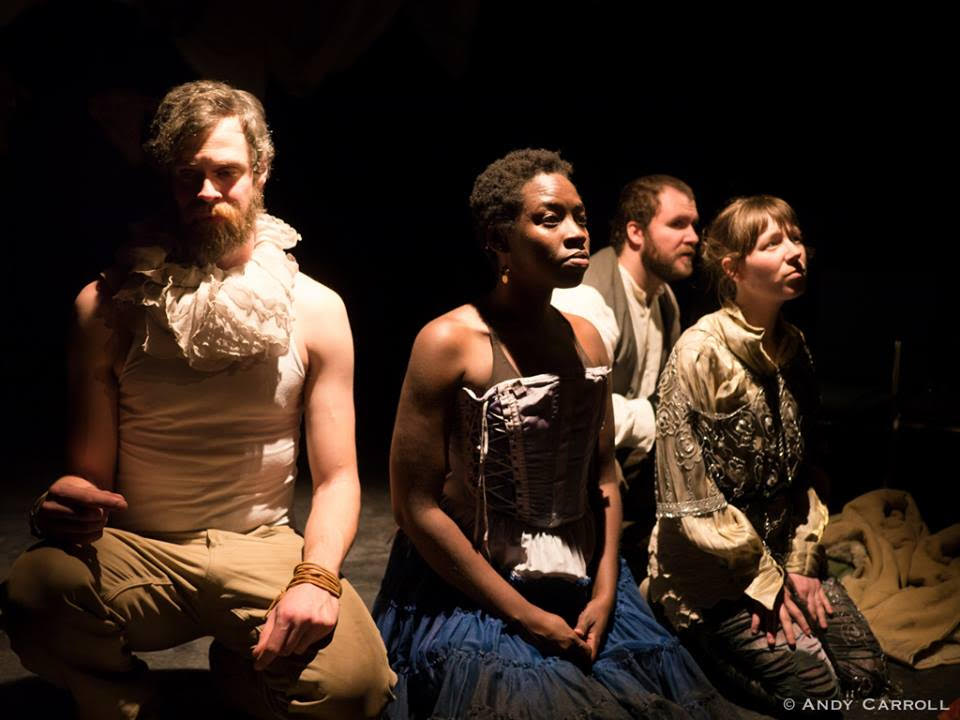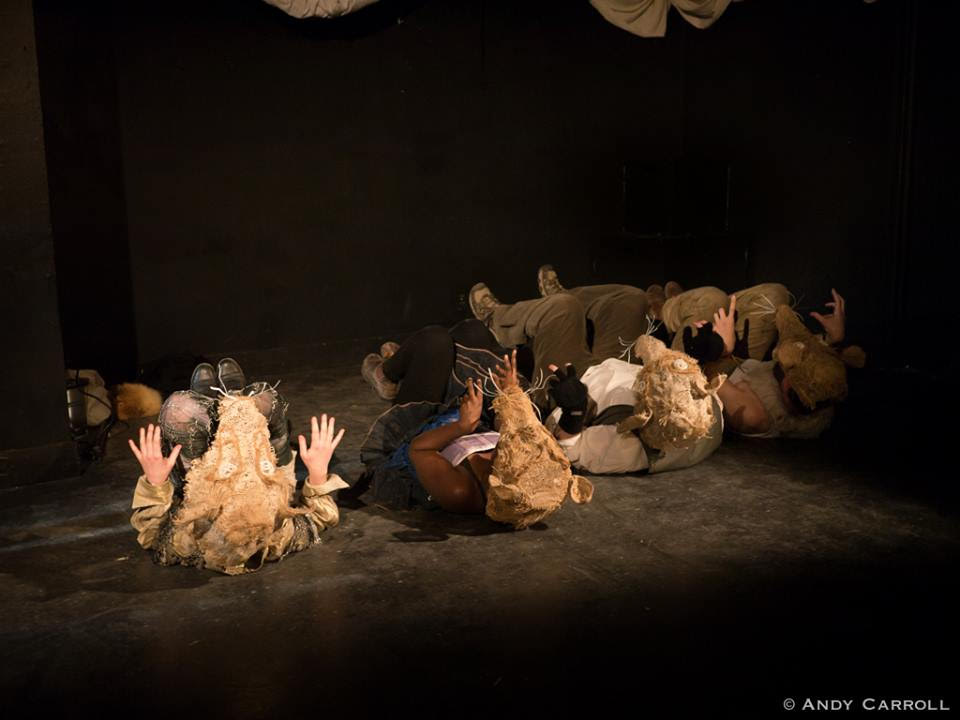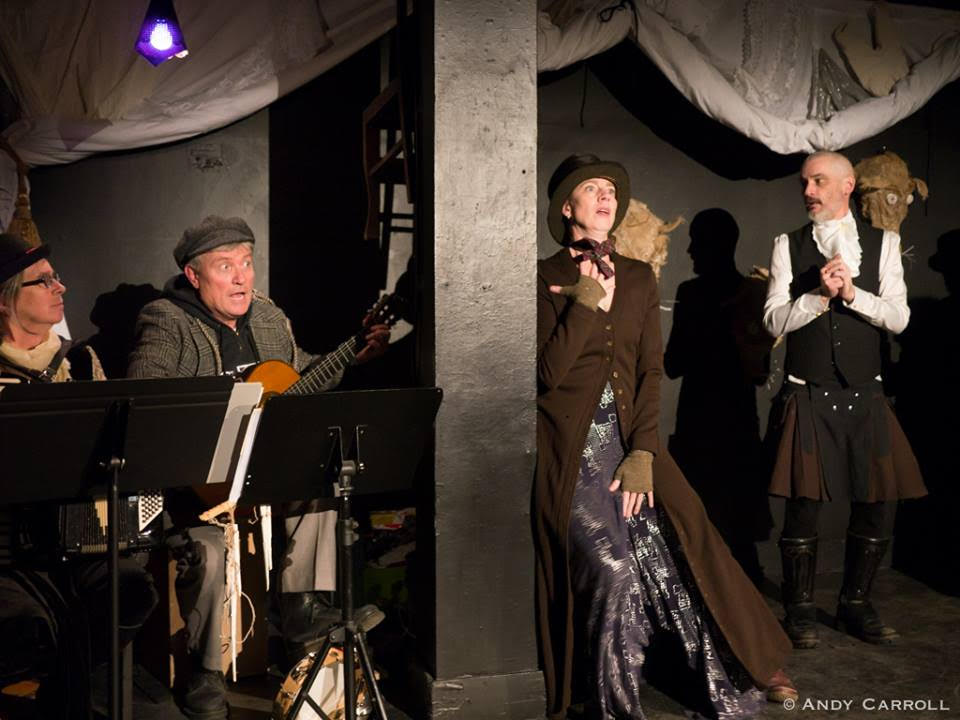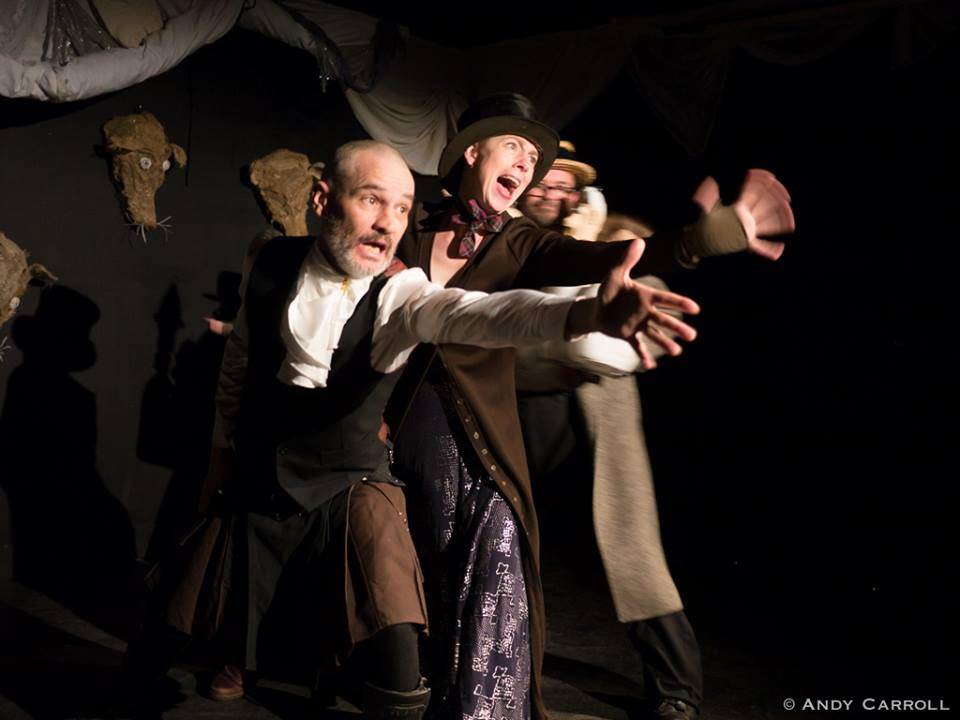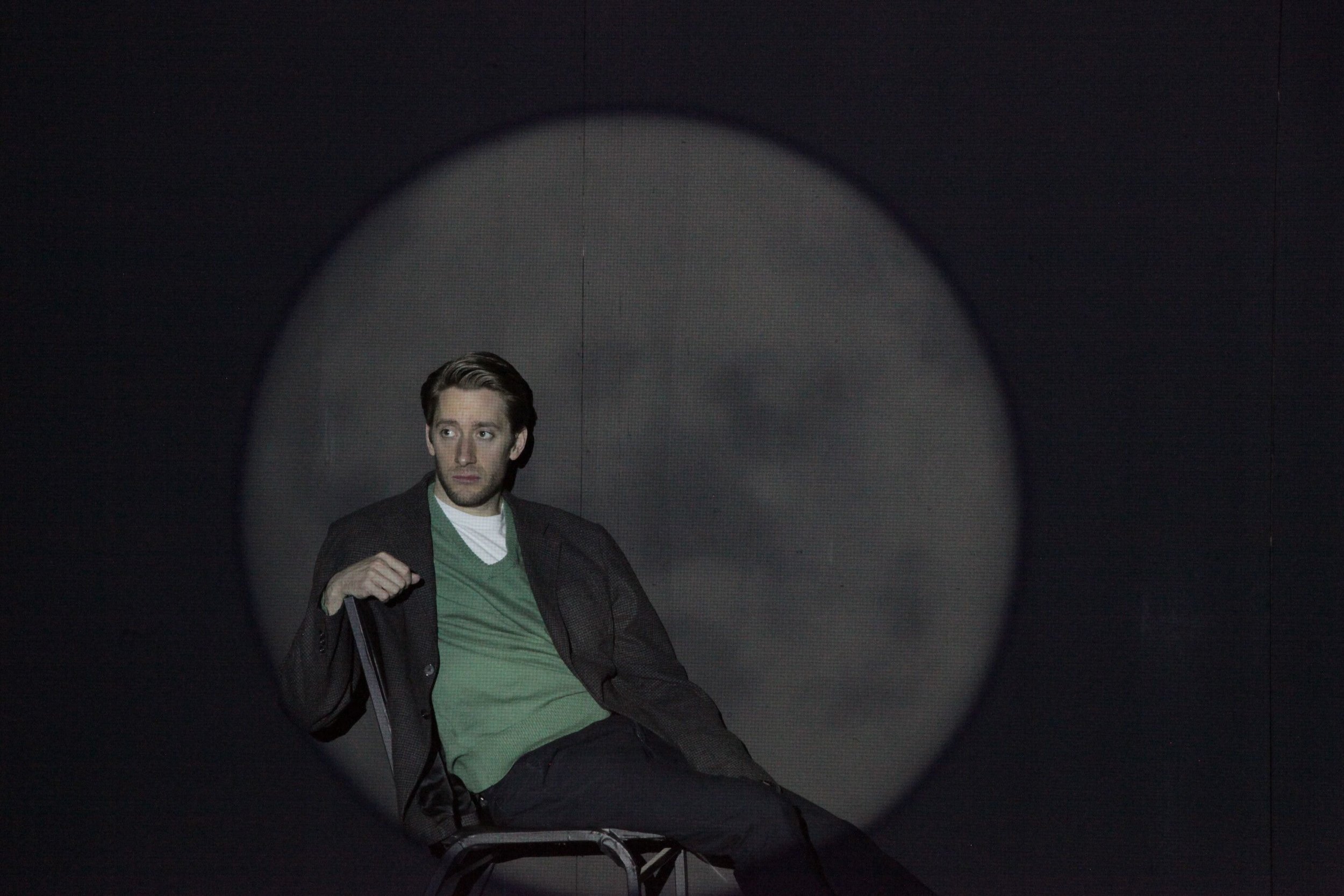Director Shira Taylor celebrates a successful show in Kapuskasing, Ontario to kick off SExT's 2018 National Tour.
Photo by Thuriga Bala
Charmaine Chang and Lauren Chang serenade a Zoom audience about the 10 steps to condom use during a virtual pandemic performance.
Photo by Shira Taylor
Dr. Shira Taylor is a public health advocate and theatre artist who completed her PhD at the Dalla Lana School of Public Health at the University of Toronto. She is currently embarking on a CIHR postdoctoral fellowship at York University. Shira employs participatory theatre techniques to engage youth in critical dialogue, skill development, performance creation, and activism on stigmatized topics related to sexual and mental health. As her dissertation, Shira created, implemented, and evaluated the award-winning workshop and performance program, SExT: Sex Education by Theatre, in an immigration destination of Toronto. SExT is an innovative theatre-based program designed to address sexual health inequities facing newcomer and Indigenous youth in a way that celebrates diverse identities. Since 2014, SExT has been performed by youth peer educators over 100 times for approximately 10,000 youth. SExT was performed to rave reviews at The Toronto Fringe (2016 & 2021), Camden Fringe (2021), and SummerWorks. Since 2018, SExT has toured nationally to Indigenous communities disproportionately affected by HIV and STIs in partnership with the Canadian Foundation for AIDS Research (CANFAR). SExT received the ArtBridges/ToilesDesArts Remarkable Innovation Award, and Shira received the TD Michaëlle Jean Bursary for excellence in addressing issues of national concern through art. In 2019, Shira was awarded CIHR Gold and a Gairdner Award from among the top 5% of Canadian PhD candidates. Shira was Research Coordinator for the SSHRC-funded Art for Social Change (ASC!) project, working closely with artists and change-makers to further the arts in social change agendas. She currently sits on the board of directors of the International Centre of Art for Social Change (ICASC).
Website www.sexeducationbytheatre.com
Fringe promotional graphic featuring Joseph Zita as The Rona, Emma Wheaton as Captain Condom, and Michelle Nyamekye as The Clap.
Graphic by Isfandyar Virani
transcript
[00:00:05.750] - Robert
Shira. Thank you. Thank you so much for doing this and agreeing to spend an hour chatting about your work. I'm so excited. Can you introduce yourself, however it is you wish to do that today?
[00:00:19.110] - Shira
Absolutely. So my name is Shira Taylor. I'm a theatre artist, director, producer, and public health advocate and researcher. That class that you're referring to was actually the night before I defended my PhD thesis. I did my PhD in public health at the Dalla Lana School of Public Health, and I think it was three days after that that the University completely shut down for COVID. So I really snuck under the wire there. After a long, fulfilling, and arduous PhD journey. As part of my dissertation, I started the program SExT, which stands for Sex Education by Theatre. And SExT is a theatre-based, peer education, trauma-informed, sexual and mental health workshop and performance program that celebrates culture as enriching the sexual and mental health conversation.
[00:01:16.950] - Robert
Amazing. That's great. Yeah. You must have been one of the last students to defend in person.
[00:01:25.180] - Shira
I think so.
[00:01:26.670] - Robert
And not walk across the stage, and not walk across the stage in person too.
[00:01:30.680] - Shira
No. I watched that graduation ceremony from my bed.
[00:01:35.550] - Robert
That's a great ending to the degree.
[00:01:38.090] - Shira
Yeah. Very climactic.
[00:01:40.180] - Robert
I'm really interested in where this marriage of public health and epidemiology and theatre came from, how that began.
[00:01:49.470] - Shira
Absolutely. So my theatre journey started when I was nine years old, and I sang 'I Can Show You the World' at my uncle's wedding. And people were like, you should do theatre. And I said, okay. So I started getting very involved in musical theatre from when I was nine upwards. At the same time, I was going more the science route with my academic pursuits, so I would always do science academically. I did my undergrad and psych science, and then I did a master's in epidemiology. But at the same time, I was always on stage, always performing. And in my first year at Queen's University, when you're like a really nervous frosh, they have this program called Existere, and they take all the frosh, they shove them in a room, and you just played this horrible icebreaker game with your floor, and you don't even know how to do laundry. I'm assuming most people knew how to do laundry, but I didn't because I guess I was a little bit spoiled with the laundry. And all of a sudden, these people who are a year ahead of you are on stage, and they're showing you how to do laundry through song, and they're making fun of the horrible icebreaker game you just played.
[00:02:54.670] - Shira
And they're talking about more serious issues like mental health and sexual health. And I was like, in the audience, like, they get me, and you could feel in the room. Everyone went from being so awkward, and then we're laughing together, and you could feel like a sense of community built by the end of this show. So after that, I was like, okay, I must do this. So in my second year, I acted in that show. And then in my third year, I directed it. I co directed. And then after that, I worked with the Dean to make this a program that went all year round that was responsive to community needs. Throughout the year, we call that, Excetera. And that was kind of how I realized the power of theatre for social change. And then I remember I was finishing my Masters. My Masters was very isolating, very numbers heavy. So I was looking at caregivers of people with schizophrenia. And I remember I was doing this research, and I was working with a database from a survey, and it came to the park where it was asking you, like, okay, why do you think these trends are present?
[00:04:04.930] - Shira
And I remember thinking, I'm sitting in epidemiology, it's you and the numbers. So I was sitting with the numbers, and I'm trying to come up with ideas. And then I'm like, why don't we just ask the people? Why don't we talk to people? So that was my shift away from quantitative research into mixed methods research. And then I was just brushing my teeth one day, and I was like, why am I keeping these parts of my life separate? Why don't I just bring them together? I don't know why the teeth brushing is relevant, but it's the truth. And I was like, and then I was like, why don't I do a PhD and try and marry these two areas? So in my PhD, I brought together my theatre; I brought together what I had learned from epidemiology because I learned there's a lot of gaps in the evaluation. The practice of art for social change is so beyond the literature and the research and understanding ‘how.’ So I kind of found myself in a unique position where I could look at qualitative research and arts-based research and quantitative and kind of marry all of those together.
[00:05:09.730] - Shira
And in terms of sexual health, it's an area I've always been interested in. I grew up in an extremely Liberal Jewish home where sex was a regular talk at the dinner table, like my Zaida, My grandfather would be like, “Esther, do I have an appointment tonight?” And 'appointment' was sex... And she'd be like, “Oh, Harry, you're just going to get a headache.” So that was kind of my childhood. And then I was exposed to environments where sex was so taboo that young people were actually sick and sometimes dying because people were so scared to talk about it. So I found that was a really passionate area for me, that if we can break down, find ways to break down stigma, can we protect public health? And then in terms of mental health, in doing this work, I realized that really sexual health and risky sexual behavior is so intensely tied to our sense of self and worth and our mental well-being. And then that was a really long answer, but that's kind of how all of this came together into SExT.
[00:06:12.090] - Robert
That's wonderful. That's amazing. I was wondering what the pitch was to do a PhD in this topic in the School of Public Health, but it makes perfect sense. It's incredible.
[00:06:24.930] - Shira
Yes.
[00:06:25.240] - Robert
I'm wondering if you could take me through. And I know that in the last few years, SExT has grown into a very multifaceted project with music videos and tours and school programs and Fringe shows and publications and the dissertation. But can you take me through the beginnings?
[00:06:46.650] - Shira
Absolutely. So I knew that I wanted to do sex education by theatre, but I wasn't exactly sure where I should do this or who would be receptive to it. And it was very important to me to work from a participatory action research, community-based approach where I wasn't just going into a community and being like, “you love this.” I wanted to make sure it was something the community wanted and that I was meeting people where they're at and building something that was actually coming from them and responsive to community needs. So I had been touring around different schools in Toronto, and my aunt's friend was a social worker at Marc Garneau Collegiate Institute, which serves Thorncliffe and Flemingdon Park community. And this community is an immigrant destination. It also has the highest child poverty rate in Toronto at 60.1%. There's also such diversity, such rich cultural identities there. It's a really vibrant community as well. And when I went there, I was an outsider, and I was in the office, and I had given impromptu pitch to the school principal, who was amazing and was really receptive. And she was like, this sounds great. So I was like, but I really want to talk to kids because I want to know if this is what they want.
[00:08:08.980] - Shira
And just. It was fate. There was a teacher who was actually in the office complaining about a young male student who was doing something inappropriate to a banana in her class. And I was like, It's fate. So I'm like, Hi, I'd really like to talk to this banana boy. And they're like, okay. So they called this boy down to the office, and he looked terrified, like he was maybe going to get in trouble or expelled or something. And I'm like, Hi. So I have this idea for a program where we sing and dance about things like chlamydia and homophobia. What do you think? And he's like, well, that sounds like a really cool idea, but you're not going to be able to get girls in this neighbourhood to talk about sex, so you should make it a boys only program. So I thought that was very interesting. And there is a very religious reputation in the community. It's a majority South Asian Muslim community, and it's in a very religious community. And it was interesting to me that this young man thought that the women wouldn't want to talk about sex. So I thanked him very much for his time, but I know better than to take his word for it.
[00:09:18.890] - Shira
So I asked to speak to a girls gym class, and I went into the girls gym class, and I started my little pitch. And within a second, one of the girls is, like, shot up her hand. So I asked her if she had a question, and she said, no, I just really want to do this. And then all the girls are like, I want to do this, I want to do this. And then I wasn't prepared. I was just scouting the school. I didn't have a sign up or anything, but I ended up taking old receipts out of my purse so they could give me their email address. And they were just launching into stories about major gaps in arts programming in the community. So that was one big draw. And they were saying things like, there's no dance program here. I love dancing. So I taught myself to dance on YouTube. And now I run free dance lessons for younger kids at the library. And I was like, oh, that's incredible. And then also they really wanted to talk about these issues, and we're excited. So I decided to make it a mixed gender program open to all genders, which was also not what the literature recommended.
[00:10:18.850] - Shira
The literature around sex ed, especially in immigrant communities and places where there's a lot of stigma tells you keep genders separate. And so that was kind of something that I went off the cuff on, but it really paid off. It was a really powerful program component because people got to understand each other better, and a lot of them hadn't had the opportunity to have that kind of interaction with the opposite sex. And in a heterosexual context, it's like they're maybe going to have sex with these people, but they don't know how to talk to each other. Right? So that was really interesting. And then the program started. I did ten workshops after school, so I partnered with the Flemingdon Health Center across the school from Marc Garneau. And they were incredible. They gave me space, and the kids would come over after school. We would do workshops, and I would give them the chance to come up with skits songs, raps, and dances. We would do theatre training. We would have discussions. And at the end of that process, I kind of went aside and did some dramaturgy on their scenes, pulled together a script, and then I brought them back for a week of the summer, and we rehearsed.
[00:11:32.250] - Shira
And at the end of the week, we had a 75 minutes theater performance that we performed for their peers in the community at the Ontario Science Centre. And it went better than I could have possibly imagined. And that kind of was the beginning of our trajectory.
[00:11:48.390] - Robert
That's incredible. Wow. In terms of your position in this work, it sounds a bit like a devising process really. But do you sort of see yourself as facilitator or director or playwright or more of a researcher and perhaps you just wear many hats, but how do you balance that?
[00:12:14.660] - Shira
I would say all of those things. Sometimes I feel more like a mom. Sometimes actually I'm wearing a bracelet they got me, the cast, that says like mother on it from our tour. Because I'm a tour mom, I don't think I was prepared for the impact on my life that this program is going to have when I started. So I was originally warned because of the at risk label that was over the community that kids are going to drop out on you, you need to take more. You're going to end up take. If you take 15, maybe you'll end up with five. So I originally took 15 with the hope of finishing the program with ten and I finished the program four months later with 19. And originally so leading up to the summer, about half of the kids came to me and said we really want to do the play but we have to work in the summer and we have summer jobs and we have summer school but we don't want to drop out. So I said okay, no problem. I switched my plan around so I would be with half the kids from like ten to five and then the other half would come from five to ten and then a lot of them would stay from ten to ten with me just because they loved it so much.
[00:13:33.760] - Shira
Most of them were fasting for Ramadan at the time. It was just like there was so much passion and energy for the project and I was sleeping 2 hours a night so I would go home and we'd be workshopping scenes but then I would need to have a clear script for them to memorize by the next day. So I would go home at ten and be up to like four in the morning. I don't recommend this now that we've expanded into mental health and self-care, this isn't what I would recommend, but this is how it started and I would be off like dramaturging the script all night and then I would sleep for 2 hours and then show up ready to do it again. And it was like that was the week. So if anyone is looking to base their work on this model, I would not do this in a week. But we came up with the show at the end and then now seven years later, nine of the original 19 still actively work for us as peer mentors and peer educators and performers and we've brought on new people. We have about 14 active members right now.
[00:14:40.680] - Shira
So that's what I say to the haters.
[00:14:45.070] - Robert
That's so incredible. Yes. All that while doing a PhD at the same time somehow.
[00:14:50.050] - Shira
Well, the PhD took a long time.
[00:14:56.270] - Robert
Cool. So what does SExT look like today, where everything is today?
[00:15:03.350] - Shira
So it's been a really incredible and unexpected trajectory that I feel very blessed about. So originally, this was supposed to be a four-month program. When it ended, I knew it was very special, and I didn't want to give it up. And all the kids were just, like, on such a high. And they're like, no, we're meant to be stars together. This can't end. And I said, I agree. So we ended up really, like, there was a bit of a hiatus. We did a few conferences over the next year, but we ended up getting into the Toronto Fringe and SummerWorks in 2016. And that was really a game-changer. This was around the time that the new sex ed curriculum had come out, and there were massive protests. And the protests were actually based steps away from where I was running SExT in Thorncliffe Park. And this also attracted a lot of not so flattering media attention, where ethnocultural groups were kind of being scapegoated as against the curriculum. And there was a lot of tension. The topic was really fraught. And what really struck me is that here you have all these adults yelling at each other about what's best for kids, but nobody is listening to the youth, especially from these immigrant communities.
[00:16:23.040] - Shira
No one's hearing their voices. So we really saw Fringe and SummerWorks as a chance to get the youth voice from these communities where everyone's seeing the protests on the news. What do the youth have to say about this? And it was really special. Their voices came out really strong and clear, and we got really great reaction. We got four stars from NOW magazine and Critic’s Pick and all this amazing media attention. And then Kathleen Wynne, the former Premier who was responsible for updating the curriculum, actually came to see a show, and at the end, she had tears all over her face. And she said, I think every student in Ontario needs to see this program. So that led to Ontario-wide touring program in 2017, and that was really special. (And the dog agreed that it was very special.) And then from that, we just kept doing conferences, and we performed a sexual health symposium at UofT that June Larkin organized. And there was someone there from CANFAR, the Canadian Foundation for AIDS Research. And after she came up to me, I could see, you know, when there's an audience member that's just like... (excited). I hate stage managing, but I was stage managing that one because we were missing a stage manager.
[00:17:42.200] - Shira
I ended up promoting one of our youth to stage manager, which was the best decision that I ever made. Most dependable, knows the show like the back of his hand, but I digress. I was stage managing. I could see her face the whole time. And she was into it. And she came up to me after and she said, do you want to tour Canada? And I said, yes, I absolutely do. So that led to our national touring program in 2018, where we were touring to areas of Canada most affected by HIV and STIs. We started in Northern Saskatchewan in Indigenous communities where HIV is over double the national average. And then the following year, in 2019, we actually went up to the Northwest Territories because the Chief Public Health Officer declared gonorrhea and syphilis outbreaks there. So we worked with the Chief Public Health Officer. We toured all the way up to Inuvik and Tuktoyaktuk, which is like the Arctic Ocean. We dipped our toes in the Arctic Ocean. It was very cold. We have pictures holding our SExT condoms by the Arctic Ocean sign. So that was really exciting. And we were all set for our next tour that was supposed to happen in 2020.
[00:18:57.280] - Shira
And then, like the dog says, it was very disappointing. We were not able to do that, and that kind of led us to switch online. I'm[ST1] going to try and let the dog out again. Hopefully you can edit this. I'm so sorry.
[00:19:11.050] - Robert
It's easy.
[00:19:12.300] - Shira
Keep them busy for a little bit. We will see. Oh, you're muted.
[00:19:21.870] - Robert
I've totally been there.
[00:19:24.990] - Shira
Of course.
[00:19:28.210] - Robert
Cool. Yeah. Where were we? I write the tour. That didn't happen, but that prompted a shift online.
[00:19:41.120] - Shira
Yes.
[00:19:48.690] - Robert
Yeah. I mean, it's such an incredible, incredibly rich, multifaceted project. And I'm wondering, being in the writing and research phase of my own dissertation right now, what does this look like? How do you translate this into a dissertation, into living in the Academy? Because it's such a practical methodology.
[00:20:13.230] - Shira
That's a great question. I wish I had a really nice, shiny answer. I don't. It's actually a huge challenge. It's been a very huge challenge and a lot of tension. And I think it's because the Academy, in my opinion, hasn't really kept up with the real-world impacts. And I know certain departments are doing this better than others, but I think for me, I was finding that the reason I took a long time to finish my PhD, like a long time. And I think the reason that was was my work in the real world. And I was not willing to pass up on following the trajectory of this program because it felt important, and this is why I was doing it. So if I could have the chance to travel the country and have real-world impacts and have these youth have the opportunity to do this and have such cultural exchange, and it was so beautiful, I wasn't going to say no. I have a deadline to write about for my dissertation, so I wasn't willing to do that. And I wish that the process of doing a PhD embraced that a little bit more because it did always feel like my real practical world work was in tension with me locking myself in a room and writing up, transcribing, and writing up.
[00:21:40.520] - Shira
So I collected data through that first four months of the program, which is what my dissertation is based on. And I collected survey data in line with my epidemiology background. And I did something called peer interviews, which I really loved, where instead of me interviewing the individual youth, I partnered them up and they did an arts-based peer interview, which was really rich because they could really be themselves and they had the shared backgrounds and a lot of times and shared experiences, and they could kind of play off of each other and have fun with it. Listening back to these interviews, I don't think anyone's had as much fun as I had, like, going through and transcribing their interviews, because these kids, during one of the interviews, they had a baby, and then the baby came out a different race. So there was like a big fight. And this is, like between two groups happening, and I'm just, like listening to these and dying laughing. But at the same time as all these theatrics and ridiculous things were happening, there was really rich data that came out of that. I also did other arts based data collection with scene creation, and a lot of it was like analyzing the video and transcribing and then triangulating all of this together to form a story.
[00:23:00.290] - Shira
And really what I was identifying, I didn't want this to be a traditional evaluation approach in terms of what was the impact on the youth. I did look at sexual health impact and personal and social development impact, which is especially important with immigrant and Newcomer youth, who often face social exclusion and structural barriers. So I really wanted to look at the impact. But my true research interest was the how and the why, which is often I find missing. So it's great to say my project did all these great things, but how is that going to help other people? How is that replicable? Throughout my research, I identified five mechanisms that I thought were responsible for the theatre pedagogy being able to lead to this outcome. So these were 1) pleasure and 2) personal and community relevance. Let's see how well I remember them. 3) Creative engagement, 4) role-play and embodiment and 5)vicarious role play and modelling. So those are the five mechanisms identified. That's what I focused on in my research, and I found that very fulfilling and valuable. But at the same time, I'm like off touring Canada, and then now we're working with Indigenous communities and we're bringing Newcomer and Indigenous communities together.
[00:24:21.760] - Shira
And I'm still writing my dissertation on the first four months because I couldn't find the time. And I wish that the actual performance would have been a viable thesis, like a viable research output, but it wasn't. I don't know the answer, because I do think it's important to sit down and analyze and write these things up. And maybe I should have been better at multitasking, but I do think that that's something that we need to work out in academia. So I don't think anyone should feel like in their program, going on to work with the Chief Public Health Officer and touring Canada should be seen as like, oh, you're really the department 'screw up' because you are behind in your writing. That doesn't feel right to me. And again, a lot of it is my own inability to lock myself in a room. And rightly so. I do take responsibility for that. But I would love to see moving forward us strike a better balance in academia, if that makes sense.
[00:25:31.250] - Robert
Of course. Yeah, for sure.
[00:25:33.450] - Shira
Yeah.
[00:25:33.600] - Robert
I did my MA in the UK, and the final thesis part was a completely practical performance. It was completely practice-based. But there are tensions in an institution like UofT, for sure, but certainly in the Canadian landscape as a whole, around what constitutes a research output. But if my dissertation has 1% of the impact that yours has, yours has had to bring across the country, it's incredible. I want to talk about COVID because of your intersection between epidemiology and theatre, being an artist and this project, how has the last year been for you and for your company?
[00:26:25.830] - Shira
So it's been a learning curve, a roller coaster, very hard, some wins. So one thing that's really important that I think COVID has shown us is it's really magnified inequities. And for some people, switching to Zoom is like, great, it's no big deal. But in Flemingdon Park, you often have large immigrant families in one or two bedroom apartments. Usually you start sharing bedrooms with siblings or grandparents or multiple siblings or multiple grandparents. We have to recognize that these topics are stigmatized. So across the board, I don't know any kid that wants to talk about their sex lives or their deepest mental health struggles with their grandmother or even sibling in the room. And oftentimes people are sharing devices. So right when COVID started, we were already doing music videos. We had our music video Tunnel Vision on one of the youth's experience with intimate partner violence. We had Bodak Consent, which is an empowering anthem about consent being active, verbal, voluntary. So we were already doing music videos. So we were like, okay, we can shift into the more video digital side of this work. We were also on the cusp of training a new cohort of peer educators.
[00:28:00.370] - Shira
So I actually have a few grants, and I was still excited about it. It's hopefully going to happen soon, but basically I wanted to facilitate this whole program again, train 20 new peer educators. But instead of me, the outsider doing it this time, it's these youth who have been training as theatre for social change practitioners with me for the last seven years, and they're going to run the program for other use in their community and I'm going to be there helping out, but they're going to be the stars and have a chance to shine. And I was thinking that would build community capacity and sustainability. So we were on the cusp of doing that, but we started so as soon as the pandemic happen. One thing I'm proud about is we started having weekly meetings, which we've never had before. We would work together, we would be in a touring bus together for like four weeks and have very intense time together. But then there were months where we weren't doing much, but we decided just kind of to keep everyone connected. We started every Saturday night at 10:00 PM. We had a meeting and that kept going until things opened up this summer, which I'm pretty proud of.
[00:29:06.420] - Shira
That was a long haul we had, and not everyone would come every week, but it was consistent and it was there for anyone who wanted it. And again, we're doing this at 10:00 PM. Because even with youth who have been literally belting out about their periods on stage for the last seven years, they still didn't want their parents to hear what we were talking about. So a lot of them couldn't join until 11:00 PM if their parents are like nighthawks. So we realized very quickly that if it was this hard for kids who are this comfortable with these topics to be able to engage and talk and we have to meet at 11:00 PM... I'm up all night. Like I'm just a nocturnal type person. So a lot of the times when youth start working with me, they're night owls too. And we'll be on the phone from eleven to four in the morning, like doing our work. It works for me. It's not going to work for the average person. We certainly can't bring in 20 new kids in those hours. So we realized that while everyone's trying to go online, I actually felt like the responsible thing for us to do was not to go online in terms of training new peer educators.
[00:30:15.090] - Shira
So we put that on pause till we could do it in person. Then we did have the opportunity to perform virtually. So our first performance, virtually, we all went to the CANFAR office and I got everyone these masks that had like a clear slit. And then I learned that if you rub dish soap on the clear slit, then it doesn't fog up. And I'm like, COVID police. The thermometer kept telling me people were dead. And I'm like, I don't know, I hope this is okay. And then I'm like, don't take off your mask and go outside to eat. And it was extremely stressful. But we did a virtual performance that way with us all in the room together and we had kind of got the hang of that. But then we went into full lockdown and we started doing them from the youth’s home. So that was interesting. Because it also gave us a chance to start seeing Zoom as its own medium. So just like what you're doing on stage, you don't want that to be the same as something you're doing for film. I was like, okay, we're going to treat Zoom as its own medium.
[00:31:24.210] - Shira
We're going to create for Zoom. So once I started shifting my perspective that this was its own thing and not just a stop measure, we started having some fun with it. So Zoom backgrounds are our friends. We love Zoom backgrounds. Sometimes it's, like, easier because you don't need a set and they can be hilarious, right? Also, it wouldn't work for everyone across the board. So not every one of our youth is in the home situation where they can do a show from home, but we're lucky that enough of them had the privacy. We have two siblings, so that was good. We could do scenes with two people in it, and we started doing online performances. And I was actually shocked at how these performances worked in a high school setting. And then I was like, why didn't we start doing this earlier? Because the chat function was our friend, which could go either way. But I remember our first high school performance that we did theough Zoom, the kids, every thought and feeling went into the chat. And that's something when you're doing live theatre, you don't know your audience’s every thought and feeling.
[00:32:30.550] - Shira
Maybe you don't want to know your audience's every thought and feeling, but it was incredible because the kids would be in the chat being like, this is the best Friday ever. I feel so bad for the kids who are missing this. And then they were like, is this allowed? Because we're like Captain Condom and there's, like, singing and Trump is HIV, the hugely incredible virus. And the kids are, like, losing it. And then they would pick one of our cast members and be like, everyone, press one if you love so and so. And then all the kids would be like, one, one, press two. It was so fun. And for my kids, it was like, they're not kids anymore. But for my youth, they would be like, okay, this is so validating. And we all managed to feel that special euphoric high that, I think, is the reason we love theatre so much. So that was really special to be able to create that online. And I think, especially with all the online teaching, and I think teachers and students were getting kind of tired of monotonous teaching. And then we come with our sound effects and our Zoom backgrounds and our ridiculous song and dance numbers, and it actually has been much better than I ever thought.
[00:33:48.160] - Shira
We've also started filming videos remotely, so we have two big COVID music videos. One is called 'It Wasn't Me', a Quarantine parody, and the other one is Quarantine Dream. Quarantine Dream. We actually met up in a park socially distance when we could do that. And we did a Fringe show, Captain Condom & The COVID-19 Conundrum!. And that was completely sel-filmed online. So I sent every youth a green screen, a stand and a ring light. And then I was on Zoom directing, but I couldn't really see what the camera sees. So it's like a little bit of hoping. And then one of our youth, he edited all of this, Isfandyar Virani, together in an incredible way because we had a nine person cast. Everybody is separate. And using the green screens, he edited it all together. I went through every take and labeled them for him when I was in the Northwest Territories at Sex Ed camp at the time. So it was chaos, but we pulled it together. Is it the highest quality film you'll ever see? No, but it has charm, and I'm pretty proud of how we were able to do that.
[00:35:07.590] - Shira
And they had to completely rearrange their bedrooms, their apartments, all of this to be able to pull this off. And some of it was very fulfilling. And there were times where we are all so cranky and just being like, we can't do this anymore. We need to be in person. This is so difficult and taxing. During one of our shows, we realized one of our participants had COVID. And Meanwhile, his whole family has COVID and they can't really isolate because it's a two bedroom apartment and there's more than two people. So they're doing shows with COVID. There's so many mental health issues that have arose because of the pandemic. There's economic stressors, there's family stressors in the environment. There's so much to contend with. So I like to think that hopefully more times than not, having a creative outlet was helpful. Sometimes it was an added stressor, which we would try and navigate and then be like, okay, if it's going to stress you out, let's not do it. Because the goal of this is to have a creative outlet, right? So that is my long answer to COVID-19.
[00:36:17.050] - Robert
That's wonderful. Yeah. I know it sounds like you're already doing this, but I was wondering how you might view COVID, what you're doing with SExT as a tool to start conversations on vaccinations or public health measures or stuff like that. But perhaps with those music videos you mentioned, you've already done some.
[00:36:48.650] - Shira
Absolutely. So we actually formed another partnership. We have an ongoing partnership with the Flemingdon Health Centre, which was the host. They got some COVID related funding, and we've been working with them to make COVID specific videos for the community. So we actually have a whole COVID playlist on YouTube right now. We have a bunch of small videos and really based off the reality in the community. So, for example, for our youth that had COVID, he wrote a script. He didn't want to act in it. [inaudible]... But for him. He was 24 with pneumonia and couldn't walk to the bathroom and breathe at the same time. So he really wanted to get the message out of no, this is serious for young people and also give his tips and tricks of how he survived. So we have a whole video that it's like, you know, those YouTubers make like my morning routine So we made one My Morning Routine with COVID-19 and we made a whole video showing the reality in an apartment where it's not possible to socially isolate from your family members.
[00:38:13.480] - Shira
So recognizing that reality, because a lot of the public health advice that's out there isn't helpful depending on people's socioeconomic status. So we were having people who are living it in the community, being able to have an outlet and I think for him it was a chance that he just went through a horrible experience having COVID pneumonia and the stress of his family members catching it and all of that. But he was able to channel that experience into something that could help other community members and it was also giving the rest of our youth a chance to be feeling like -- and me too --I felt so isolated and helpless in these situations but it was a chance to create something that maybe can help people. We also made a little thing of When to Call an Ambulance. So five symptoms of when you should call an ambulance because that was something that was happening and we were trying to madly Google at the time like is this ambulance time or what's happening? And also one youth made a little kind of TikTok type video about coping with her mental health and what she was doing to cope with her mental health during this time.
[00:39:22.340] - Shira
So it was really a chance, the theatre gave us a chance to contribute somehow, even though we were all locked at home.
[00:39:33.410] - Robert
That's wonderful. Thank you. I think those are all my questions but this has been wonderful and I'm so excited to share this on the Gatherings page and with my own theatre community. I think everyone's going to think that your work is amazing.
